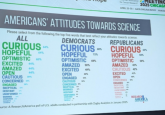The Science March: Is Resistance Futile?

The recent Science March drew large crowds to the streets in support of science. Is this resistance among scientists a passing phase or a long-term movement that will impact future policies? What do the march organizers and participants think? Find out…

The crowd at the rally preceding Science March in San Francisco.

Science March in San Francisco.

Aditya Kulkarni, a researcher at the Science March in Dallas.

Kishore Hari, lead coordinator of all the satellite marches, with BioTechniques reporter Meenakshi Prabhune at the Science March in San Francisco.
It was an unusual Saturday morning on 22nd April, 2017. The roads were packed and spirits were high as science advocates all over the world took literal steps for science by marching in the streets, holding witty signs, and chanting nerdy slogans. Their primary demands included evidence-based policy and inclusive and accessible science for everyone.
The idea of the Science March initially started as a call for action on social media by scientists and educators in Washington DC. In a short time, the idea went viral, and a million subscribers had signed up. Kishore Hari, a science educator who specializes in hosting large scale science events, remarked, “I was really shocked at the level of response!”
As Hari witnessed the increasing popularity of the march, he realized its potential to be more than a one-off demonstration. “There was some sort of real current happening in the US and I really wanted to be involved.” He ended up coordinating about 550 satellite marches across the globe.
The organizers recognized early on that the march was an opportunity for connecting scientists with the rest of the community to achieve their long-term goals. “We branded ourselves as the ‘March for Science’ and not ‘The Scientist’s March’ because we didn’t want it to be only scientists,” Bryan Dunyak, an organizer of the Science March in San Francisco, stated. He finds “humanizing science” to be the most important aspect of the march. Hari echoes the sentiment that scientists and non-scientists marching together makes a profound public statement that we all value science.
On the day of the march, as thousands flocked the streets in cities all over the world, social media exploded with descriptions of the positivity, energy, and enthusiasm of the attendees. However, skeptics doubt whether the march will have any impact on policy making. Aditya Kulkarni, a postdoctoral researcher who marched in Dallas, appreciates the unifying spirit of the march, but feels that the lack of targeted demands could render its effect insignificant. “I would be surprised if there is any impact [on policies] at all,” he said, emphasizing the need for ongoing efforts to grab the attention of policy makers.
Sarah Gaffen, a rheumatology professor who marched in Pittsburgh, is more optimistic. Although she agrees that the march won’t have an immediate impact on policy, she thinks its role in galvanizing the community into voicing their opinion and defending the importance of science is the first step in bringing about a change. “There is this sense of movement that takes many forms and this is a part of it,” she said. “I think it’s here to stay, and I am very encouraged by that.”
The organizers unequivocally agree that the march is the beginning, not the end. Hari believes that “translating marchers into action” is fundamental to ensure the propagation of science literacy, especially in underrepresented areas. In his opinion, even a fraction of marchers extending their efforts beyond the march would catalyze the long-term movement. Through the “week of action” organized in several cities immediately following the march, the organizers intend to exploit the ongoing momentum. Moreover, the official website of Science Marchenlists several ideas encouraging people to, metaphorically, keep on marching. Dunyak said, “We all understand that we got into something that’s much more long term, and [it] will not be over immediately.” He is confident that prolonged and continued movement will promote evidence-based policy in the future.
An essential step in this multi-tiered approach is also to encourage scientists to run for office, according to Hari. “Science has been and is political,” he said, addressing those who resist mixing science and politics. He fears that the place of science in society will degrade over time if science is not a part of the political conversation. Gaffen also actively works for the inclusion of science in politics and vice versa—which she believes is paramount for transparency—through her faculty resistance club.
Whether the Science March and subsequent efforts might eventually impact policies remains to be seen. For now, “It gives people some hope, and we need that,” Gaffen summarized.





